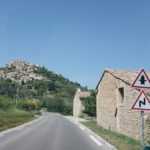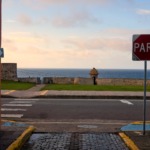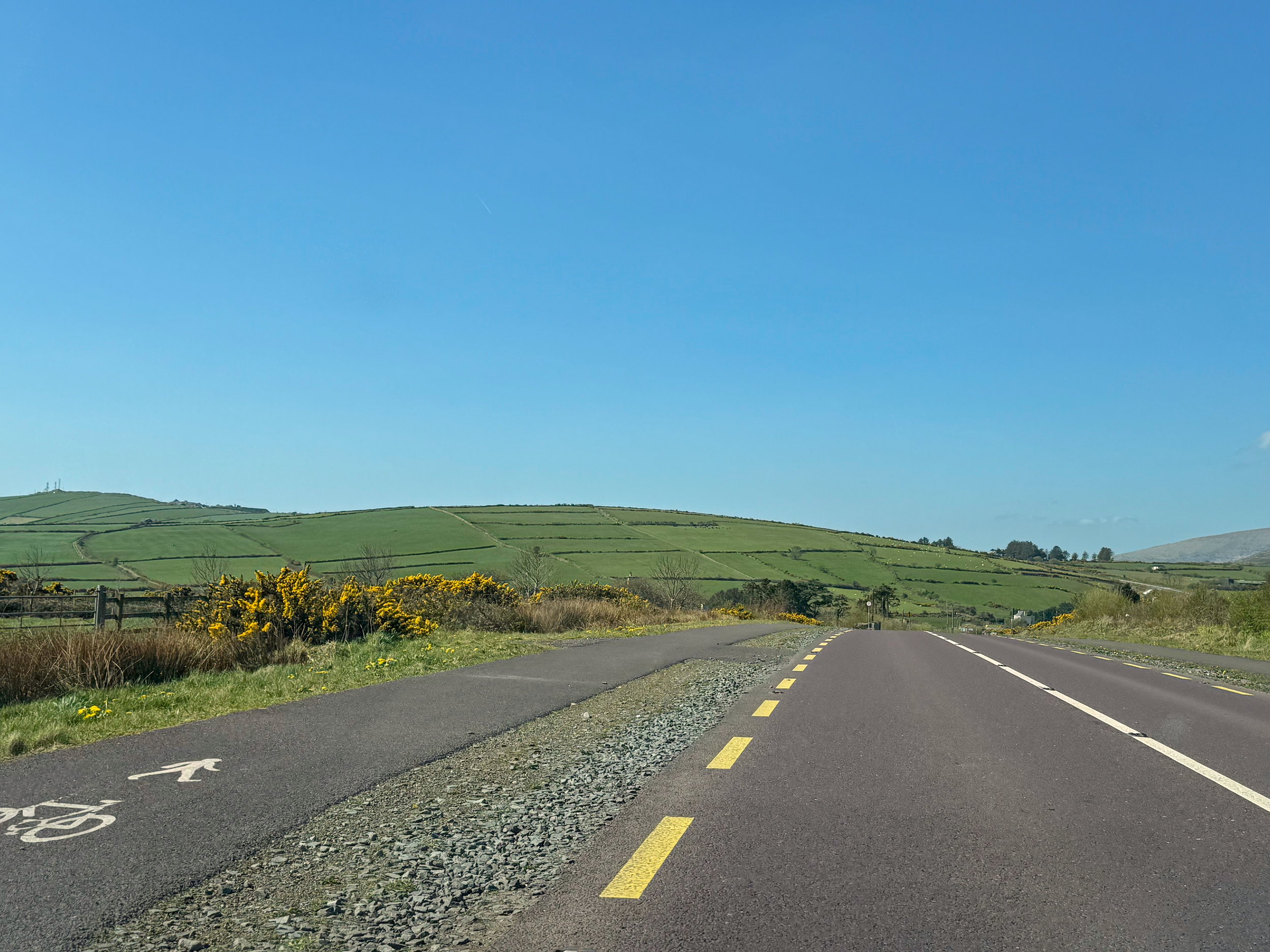

Do you really need a rental car in Ireland? Technically, no. You can absolutely see many of the country’s cities and towns by rail or bus, and fill in the gaps with day tours to visit some of the more rural sights. And I would wager that you’d still have a lovely trip!
However, Ireland is one of those destinations where having a car really does enhance the experience. The freedom to veer off course in this stunning country is what leads to those special, unexpected moments—the kind that nest permanently in your brain, filed under favorite travel memories ever.
That said, I won’t sugarcoat it: driving in Ireland is definitely an adventure. You probably already know that Ireland is a left-hand driving country. Around two-thirds of the world drives on the right, so for most visitors, you’ll be on the opposite side of both the road and the car.
But then again, driving on the left is the easy part—it’s everything else that makes driving here a challenge. Traffic rules and signage are different, so you’re constantly doing little mental calculations. Country roads? Impossibly narrow, winding, and bumpy. And then there are the roundabouts!
This post is not sponsored, but may contain affiliate links.
It’s daunting. I know, because I was just in your shoes, preparing for a week driving around the Republic of Ireland for the very first time. Well, for transparency, helping my fiancé prepare for a week of driving. We made the call early on that he would drive, and I would serve as passenger princess navigator for the trip, opting not to pay the fee for an additional driver. Now that we’re back, it only seems fair to pass along helpful tips for your first road trip around Ireland. Today’s post is written with his input, so as always, you’re getting a firsthand account.
A couple of quick notes before we hit the road: Most of my readers are from the U.S., so this guide is written primarily with them in mind. That said, even if you’re from a country that drives on the left, I think you’ll still find plenty of helpful tips for your Irish road trip. And just to be clear—this isn’t meant to be a comprehensive driving tutorial. I trust that you already have the standard driving skills under your belt and a valid license. Ready? Buckle up…
TIPS FOR RENTING A CAR AND DRIVING IN IRELAND
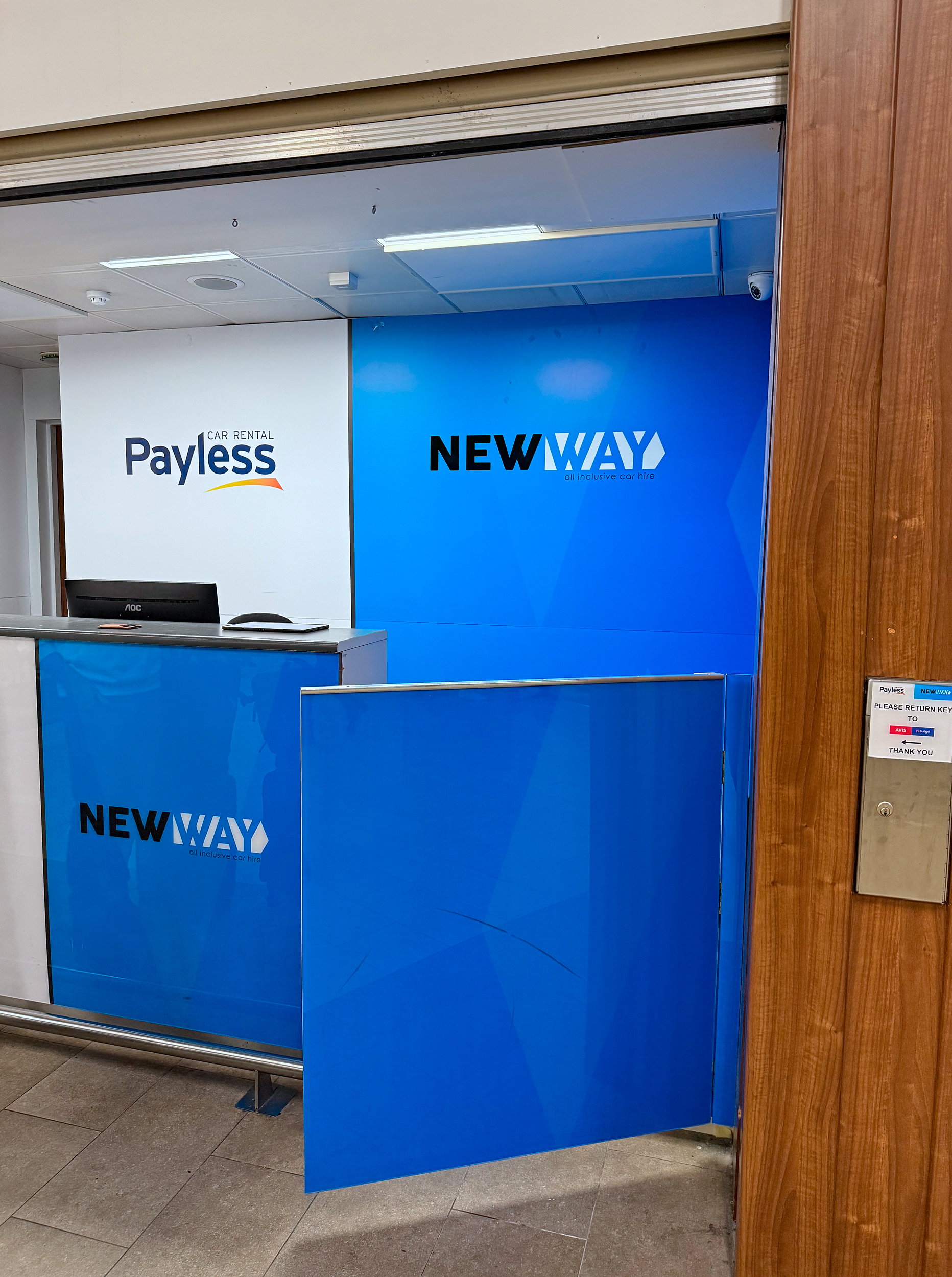
Rent from a car hire that includes insurance
Normally, I’d tell you to stick with one of the major rental companies to avoid getting scammed—but renting in Ireland is the rare exception. After oodles of research, I ended up going with a relative newcomer to the Irish rental market: NewWay Car Hire.
For about €20 more than the big-name rental agencies, we secured a car with insurance included, no deductible, and no rental deposit (yes, you read that right—but go ahead and read it again if you need to). That meant if someone sideswiped us on a narrow road or we backed into a ditch, we’d walk away without penalty. The only exceptions? We’d be liable if we lost or damaged the key, or if we accidentally filled the tank with the wrong fuel (more on that later!). There was also a refundable €250 fuel deposit charged at pick-up.
If you go the traditional car hire route, make sure you understand exactly what’s covered—and what’s not. Your credit card might offer some protection. For example, my favorite low-fee travel credit card includes primary Auto Rental Collision Damage Waiver (CDW), but it wouldn’t cover damage to someone else’s car in the event of a crash. For peace of mind, you may wish to add on extra insurance through the rental company.
Another heads-up: most car rentals in Ireland charge a hefty refundable deposit—I’ve heard anything from €1,500 to €3,000. Assuming you return the car full of fuel and in good shape, you’ll get it back, but it might take a couple of weeks. If your credit card has a lower limit, that kind of hold could be enough to max it out during your trip.
My take? We had a great experience with NewWay Car Hire, and I’d absolutely rent from them again to avoid all that extra stress and potential surprise fees.
Bring your license or International Driving Permit
If you’re coming from the U.S., a valid driver’s license should be all you need to drive a car in Ireland—but always double-check with your rental company as some may require an International Driving Permit (you can get one at your local AAA office in the U.S.). If you’re traveling from a country where English isn’t the first language, an IDP might be mandatory.
While we’re here, a quick PSA: I’ve read stories from travelers who had just renewed their license and were flagged as “new” drivers by the rental agency. If your license was recently updated, I’d recommend emailing the rental company ahead of time to avoid any last-minute surprises at the counter. And as always—get everything in writing.
Choose an automatic and the smallest car possible
In the U.S., the roads are supersized with single lanes so large that they could very nearly fit two cars side by side. In Ireland, some of the back roads are so narrow that barely one car can fit—yet, they’re intended to be two-lane roads. The lesson? Choose the smallest possible car that can fit your party and your luggage. New to traveling light? Find all of my carry-on packing lists for some inspiration.
And let’s not play macho here—now is not the time to show off your stick shift skills. Manual cars in Europe are a little different than the ones you might be used to, and unless you’re a pro at shifting gears with your left hand, just go for the automatic. It costs more, yes, but it’s worth every extra cent.
Don’t drive in Dublin
Having a car in the center of Dublin is a burden, not an asset. I recommend either starting or ending your trip in the capital, and either picking your car up before you leave for the countryside or ditching it when you return at the end of your trip. There’s far too much traffic as it is, and the city core is easily accessible on foot or by public transit. Save a few quid and enjoy your car-free time.
Safety first
All the usual safety rules apply here, but just in case: don’t drink and drive, don’t drive drowsy, and don’t drive distracted—whether by your phone or all the ridiculously cute sheep. If you need a moment to get your bearings (or snap a photo), just find somewhere to pull over.
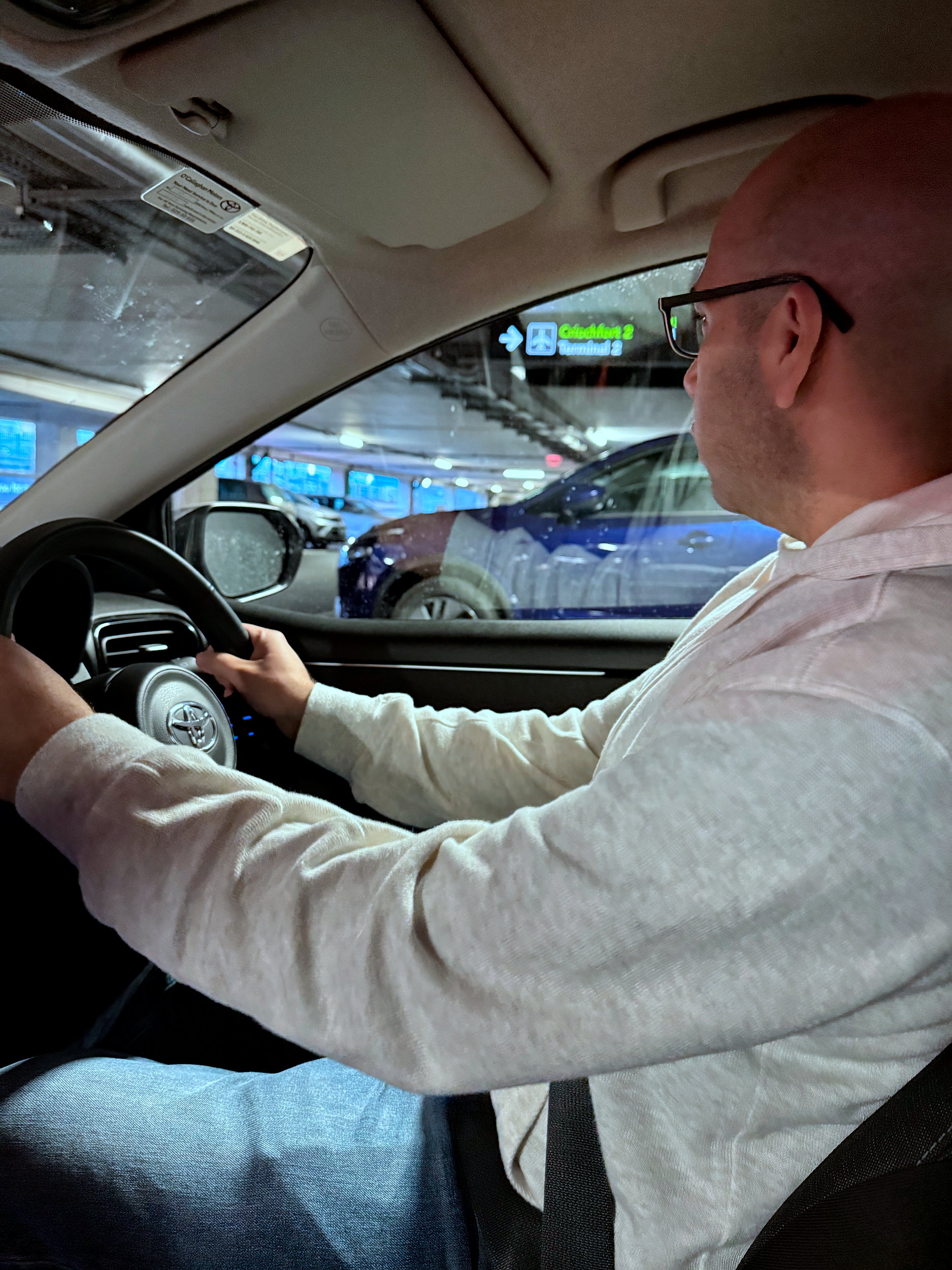

Take your time getting situated in the car
Give yourself plenty of wiggle room between picking up your rental and heading to your first destination, because the differences start before you even get inside. In Ireland, the driver’s seat is on the right, which you’ll probably forget multiple times throughout your trip. Just laugh it off—or do what we did and make a game of it: whoever tries to get into the wrong side of the car buys the next round (for the record, I ended the trip four beers richer).
Once you’re in, take your time adjusting the mirrors—especially your left side mirror, making sure you can see the lines of the road. With narrow lanes, you’ll find that you depend on your side mirrors here a lot more than you do back home. Some things will feel backward (like the gear shift being on your left), but thankfully not everything is reversed: the turn signal is still on the left, and the windshield wipers are on the right.
Designate a navigator
If you’re traveling with a group, assign one person—ideally the front-seat passenger—to act as the dedicated navigator. Their job description:
- Call out directions (whether via GPS or the classic “just follow that white car”)
- Keep an eye out for potential hazards
- And remind the driver as often as needed: “Drive on the left!”
You’re not on the wrong side of the road
This is more of a linguistic tip than a driving one, but it’s worth saying: you’re not on the wrong side of the road, you’re just on the other side. About a third of the world drives on the left—and in Ireland, you’re surrounded by them. Don’t go spouting off about it in a pub at the end of the day. Be cool.
Tight left, wide right
One of the first maneuvers you’ll do after leaving the rental lot is turn—and this is where it gets a bit tricky. In Ireland:
- Left turns are tight and easy (you’re staying in the left lane)
- Right turns are wide and harder (you’re crossing traffic going both directions)
This wasn’t intuitive to us at first. When there’s traffic, it’s easier to follow the flow. But if you’re on an empty road, it’s surprisingly easy to turn into the wrong lane out of habit. Our solution? Create a mantra. Ours was “tight left, wide right,” and we repeated it at every turn until it became second nature. Feel free to steal it, or make your own.

Here’s your sign
If you’ve driven in Europe before, Irish road signs will look pretty familiar. But a refresher never hurts. You can find a full list of Irish road signs here.
Do you need to memorize all of them? Thankfully, no—unless you’re planning on taking the Irish driving test. Most signs are intuitive, but it’s good to know that place names are typically listed in Gaelic first, then English. Don’t panic if you don’t immediately recognize a town name—it’s probably the same place you’re looking for, just in a different language.
Traffic lights in Ireland are a little confusing
The good news? You won’t encounter many traffic lights outside of the major cities. The bad news? Cities have a lot of traffic lights—and I don’t just mean scattered across neighborhoods. I mean that at a single intersection, there might be four or five. It’s not always immediately clear which one is for you.
As you approach, you might first spot a light well ahead of the intersection—this one’s a heads-up: either slow down or cruise on through. Once you’re at the junction, the main light might be directly in front of you or slightly off to the right. The sequence runs green, amber, red (as you’d expect), but if you’re on a multi-lane road, you might see several lights lined up side by side, each with directional arrows for turning or going straight. Just make sure you’re looking at the right light for your lane.
It probably goes without saying, but don’t run red lights in Ireland. Not only is it dangerous, but it could come back to haunt you financially.
No turn on red
Unlike in the U.S., you can’t turn left on red in Ireland, even if the road is totally clear. When you hit a red light, just take a moment: breathe, unclench your hands, and enjoy the pause. It’ll turn green soon enough—and then you’ll be good to go again.
Don’t block the box
At larger intersections, you’ll probably come across hashed yellow box junctions. These are designed to keep traffic moving and intersections clear. If the light is green, you can only enter the box if you’re sure you’ll be able to exit it before the light changes.
It’s pretty intuitive once you’ve seen it in action, but it’s just not something I’ve commonly seen marked quite so clearly back home. The more you know!
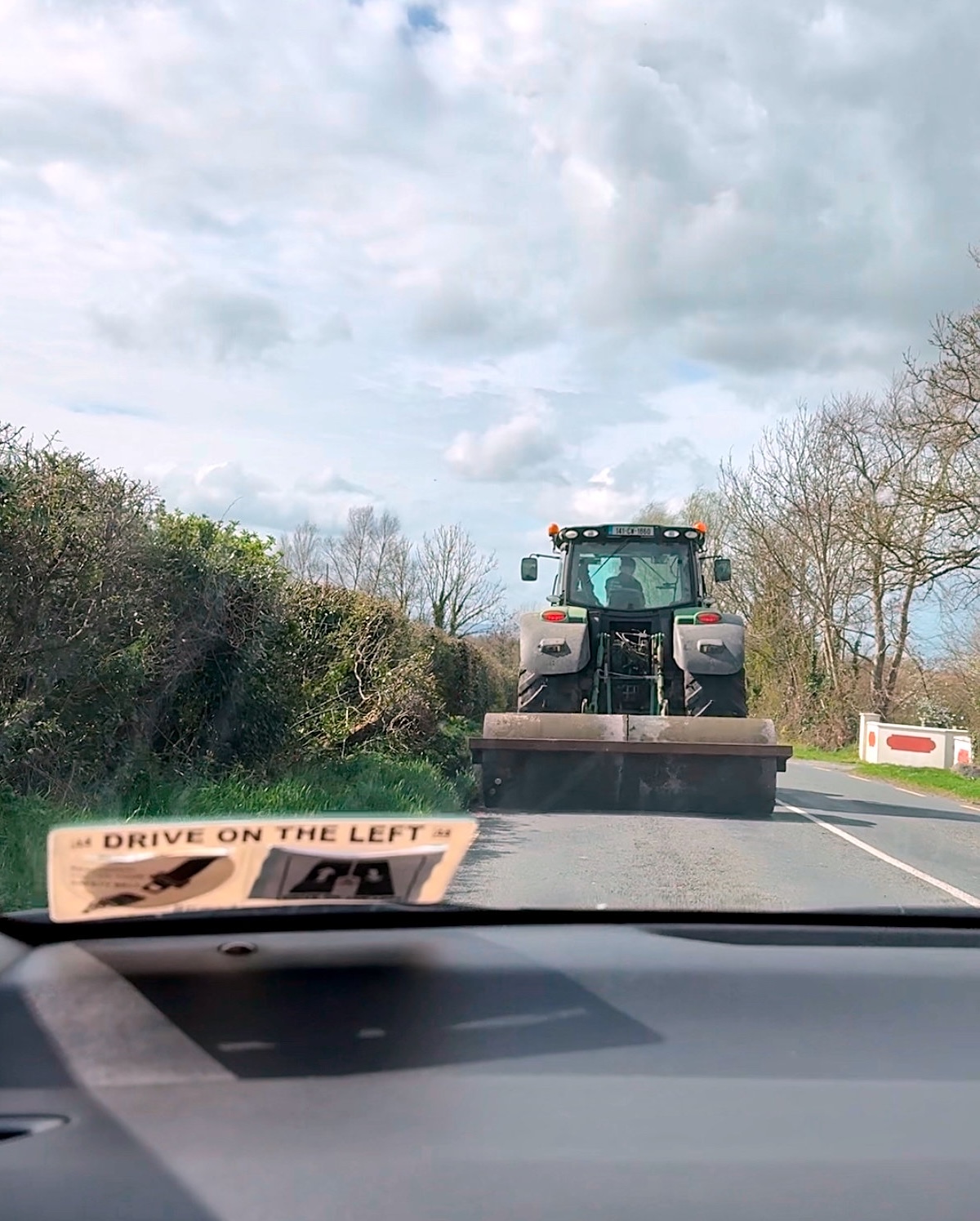
Drive on the left, pass on the right
With left-hand driving, the left lane is the slow lane. Stick with the flow of traffic in the left lane, and if you need to pass someone, pop over to the right—then move back over when you’re done. Just don’t cross the solid white line, which indicates no passing.
Watch your speed
Speed limits in Ireland are generally set by road type, and they’re clearly marked in kilometers per hour. Unless otherwise posted, the speed limits are as follows:
- Motorways (M-roads): 120 km/h
- National roads (N-roads): 100 km/h (this will drop to 80 km/h at the end of 2025)
- Regional roads (R-roads): 80 km/h
- Rural and local roads: 60 km/h
- Town and city roads: 50 km/h
It’s a lot to remember, but thankfully, speed limits are usually visible in Google Maps, and I found them pretty reliable. Our car also picked up the limits automatically from road signs—but your mileage may vary (literally).
In addition to staying safe, you’ll want to keep an eye on your speed due to the plentiful speed cameras around the country. Google Maps (via Waze) often gave us a heads-up when we were near one, but honestly, it didn’t change much about our driving habits—Michael pointed out that the speed limits always felt spot-on. He wouldn’t have wanted to go faster, even if he could.
Most other drivers seem to agree. We rarely saw anyone speeding, but you might get a local tailgating you on a familiar-to-them, yet butt-clenching-to-you twisty back road, itching to go faster than you’re comfortable. If that happens, just pull over when it’s safe and let them pass. You’ll both be happier for it.

Get ready for roundabouts
Unpopular opinion (at least in the U.S.): I love a roundabout. I think they’re more efficient than a traffic light and less confusing than a four-way stop. Apparently, the Irish agree—and I’d venture to say they love roundabouts even more than I do. By the end of your trip, you’ll have so much roundabout experience that you’ll practically be an expert. But first, you’ve got to survive your first one (traveling clockwise and all!).
While I could write out a tutorial on navigating Irish roundabouts, this is one of those situations where a video really is best. This YouTube video does a great job of explaining everything clearly and efficiently. The most important parts to focus on are looking to the right for oncoming cars and knowing which turn indicator to use. I highly recommend both the driver and the navigator watch this video a few times before your trip (just be sure to come back here afterward—there are plenty more helpful tips below!).
The bus is more important than you
In many cities, buses have their own lanes—and they pretty much have the right of way, even if not officially, but by sheer will. Pay attention to lane markings and avoid parking in bus stops. Trust me, you don’t want to make an Irish bus driver mad.


How to pay tolls in Ireland
There are several toll roads in Ireland, and while you can set your GPS to avoid them and save a little money, you’ll likely end up spending more of your time instead (ah, the classic time vs. money dilemma). With one exception, all toll booths in Ireland accept both cash and cards to cover the cost of the toll.
That one exception? The M50 toll near the Dublin Airport. It’s barrier-free, meaning you just drive through and it gets billed afterward. When renting your car, check with the rental company to see how they handle this toll—every company has a different process and you don’t want to get stuck with a fine for nonpayment.
Get lit
Your rental car will probably have daytime running lights (DRLs), which are great for visibility, though they’re not required during the day in good weather. But at night or in poor conditions, you’ll need to turn on your dipped or high beams as appropriate.
Driving through dense fog? Be sure to use your fog lights—but only then. It’s actually illegal to drive with your fog lights on when there is normal visibility in Ireland.
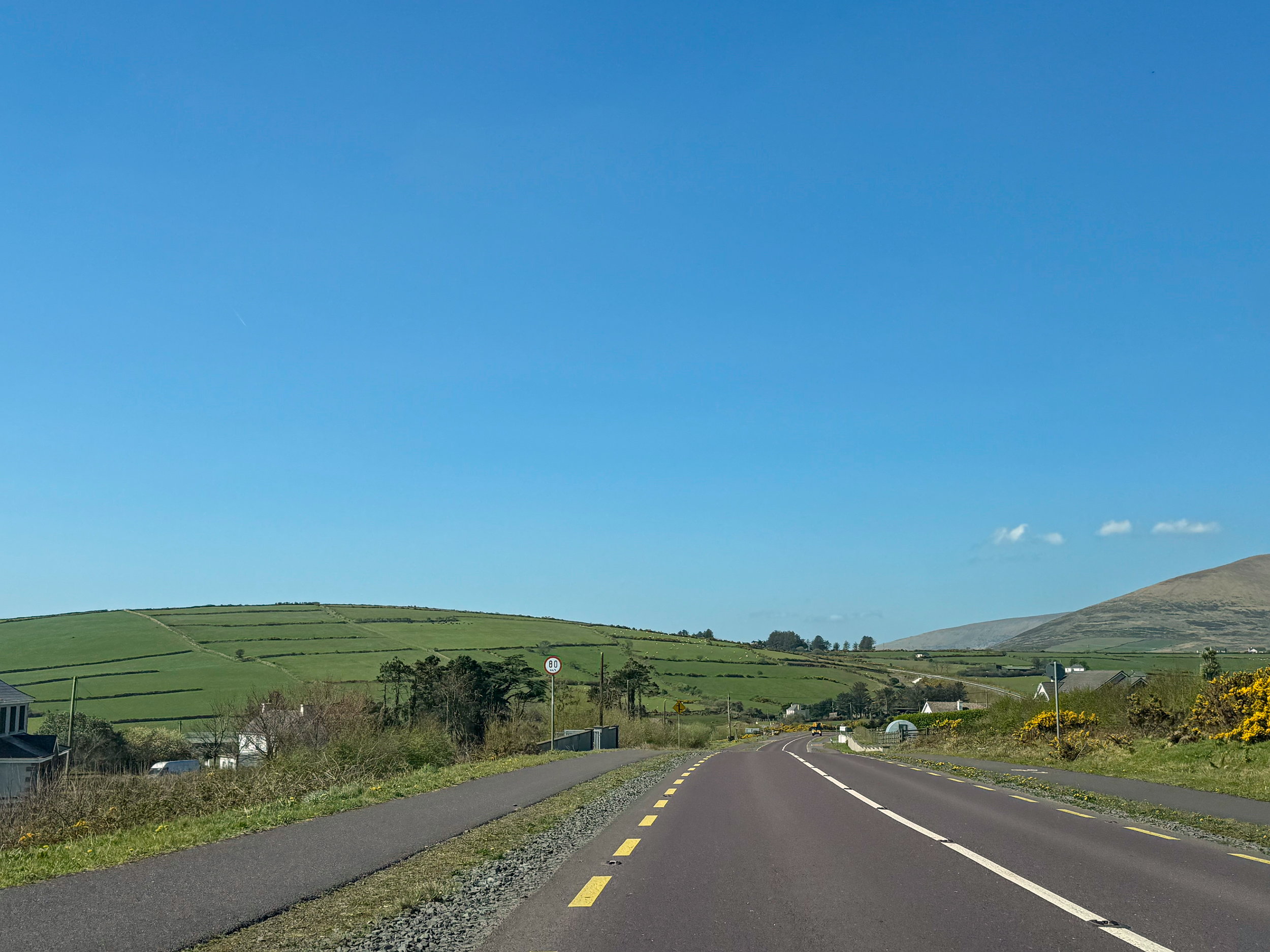
Squeeze in tight
I mentioned this earlier, but it bears repeating: choose the smallest rental car you can reasonably manage. Rural roads can be incredibly narrow, and sometimes you’ll round a bend only to find another car heading straight for you with about three seconds to figure out how you’re both going to fit (sometimes it’s even a tractor!). Our rental car definitely picked up more dirt on the left side than on the right, thanks to all the wall-hugging on these challenging drives.
The good news? Irish drivers are both highly skilled and very courteous. There’s an unspoken rule that the car with more shoulder (or at least, more space between them and the cliffside) will pull off to let the other pass. When someone does this for you, wave your thanks—and pay it forward whenever you can.
Always try to make eye contact with the oncoming driver before you start this charming little rural road dance (remember: the driver will be on the opposite side of the car from what you’re used to!).
The GPS is a liar
Okay, that’s a little harsh. The GPS (or satnav, as you’ll hear in Ireland) is generally pretty accurate, and navigating to a destination is especially easy thanks to the Eircode. Only once over the course of six days did it try to send us down a private, gated road.
But here’s the thing: the ETA is often way off, especially once you leave major highways. On rural and local roads, expect to take at least 30% longer to reach your destination than predicted. Leave yourself a buffer, especially if you’ve got a reservation or are trying to make sunset at a scenic stop.
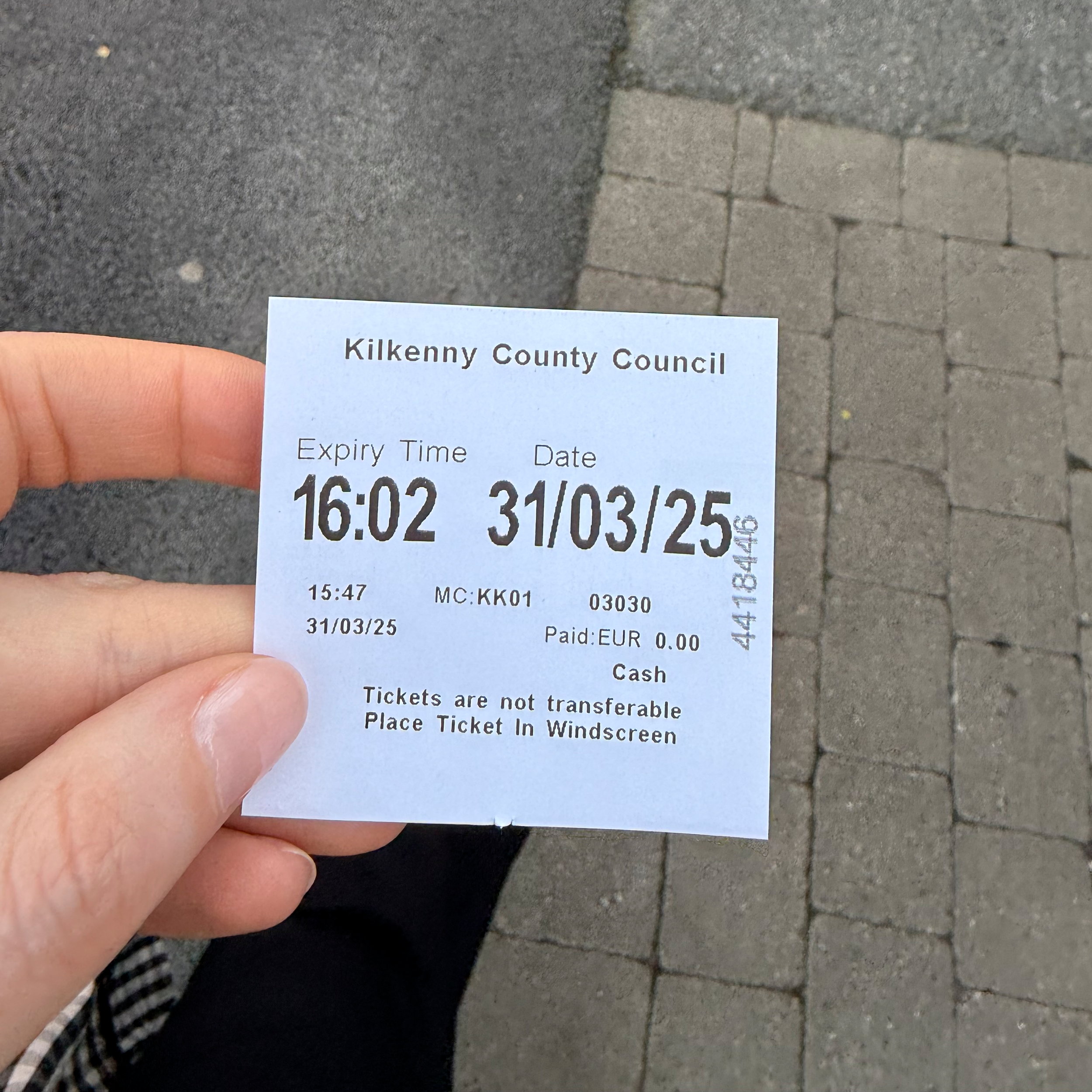
Practice parallel parking
I can’t guarantee much in this life, but I can almost guarantee you’ll have to parallel park at least once during your trip. Maybe you’ll luck out and find a pull-in spot, but chances are, you’ll need to parallel park on the left. It sounds intimidating, but it’s really just like doing it at home—just reversed. Most rentals come with a backup camera, which makes things easier.
But one aspect of parallel parking in Ireland surprised me: it’s perfectly normal for cars to park facing either direction on the street—yes, even against traffic. While it’s generally recommended to park with the flow of traffic, it’s not illegal to do otherwise. Either way, don’t be afraid to reattempt your park job or ditch a tight spot entirely. It’s far less embarrassing than scraping another car, I promise.
Before walking away, triple-check posted parking signs. In small towns, parking may be free, but in other areas, you’ll need a few coins for the meter. Some machines accept cards, but not all—so come prepared.
Don’t forget your two-wheeled friends
Keep your eyes peeled for cyclists and motorbikes. Give bicycles plenty of space when passing, and be mindful of motorbikes at intersections—they often squeeze up alongside cars while waiting for the light to change.
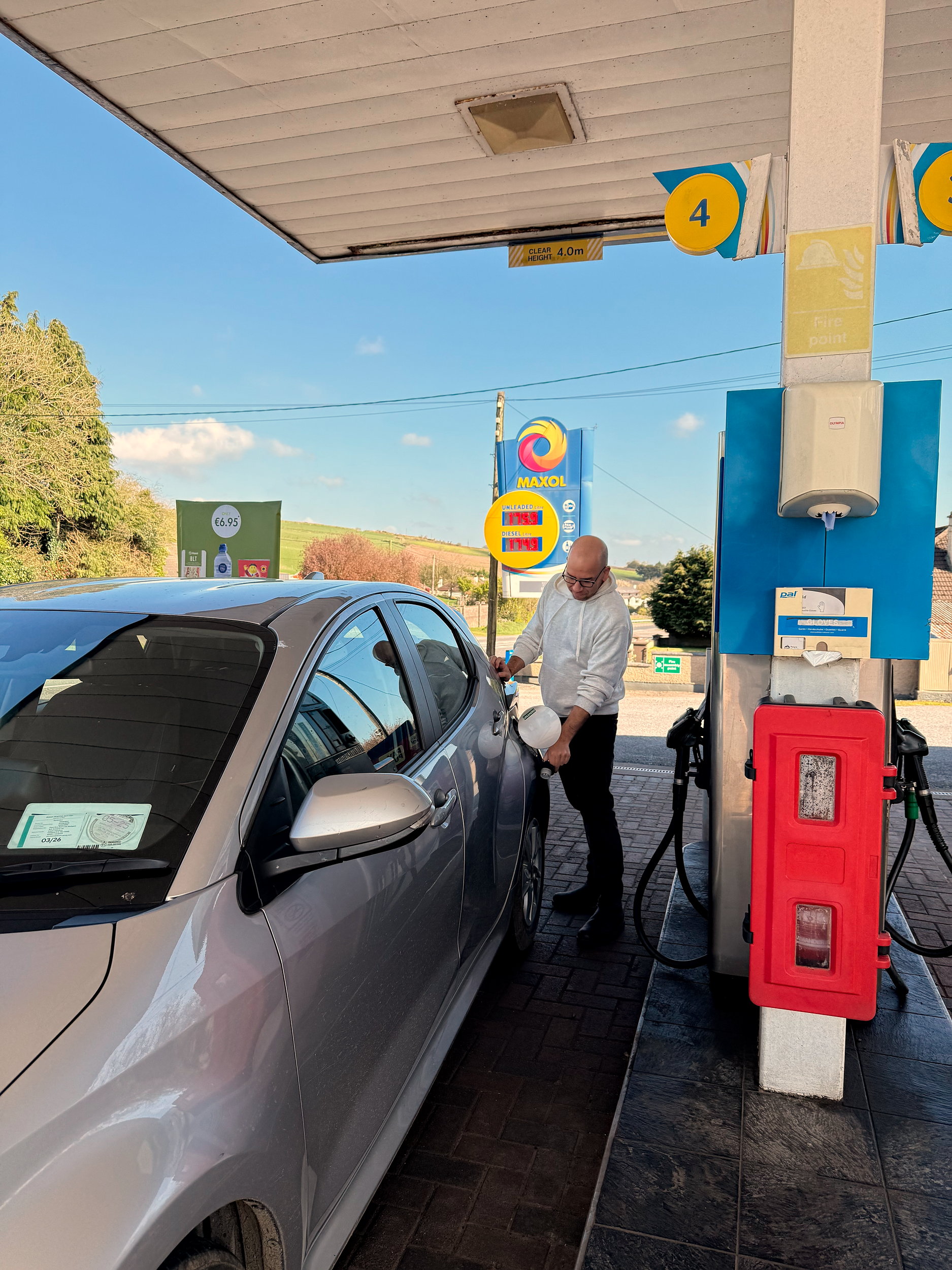
That’s gas
In Ireland, “that’s gas” is slang meaning something is funny. But you know what’s not funny? Putting the wrong fuel in your tank.
Ask at the rental counter whether your car takes diesel or petrol (gasoline)—you’ll need to know when you refuel. Also, pay close attention at the pump: in Ireland, green = petrol and black = diesel. That’s the opposite of what we’re used to in the U.S., so double- and triple-check before pumping. Misfueling can be an extremely expensive mistake.
And yes, at most petrol stations in Ireland, you can pump and then pay inside. Alternatively, you can also prepay inside if you know how much fuel you want to purchase or you may be able to pay at the pump with your card. With our Chase cards, we had mixed results with them working at the pump, so be prepared to go inside if needed (it’s best to fuel up during business hours).
As always, be sure to return your car to the rental company full. You have far better things to spend your hard-earned vacation money on than overpriced fuel, right?
FINAL THOUGHTS ON RENTING A CAR IN IRELAND
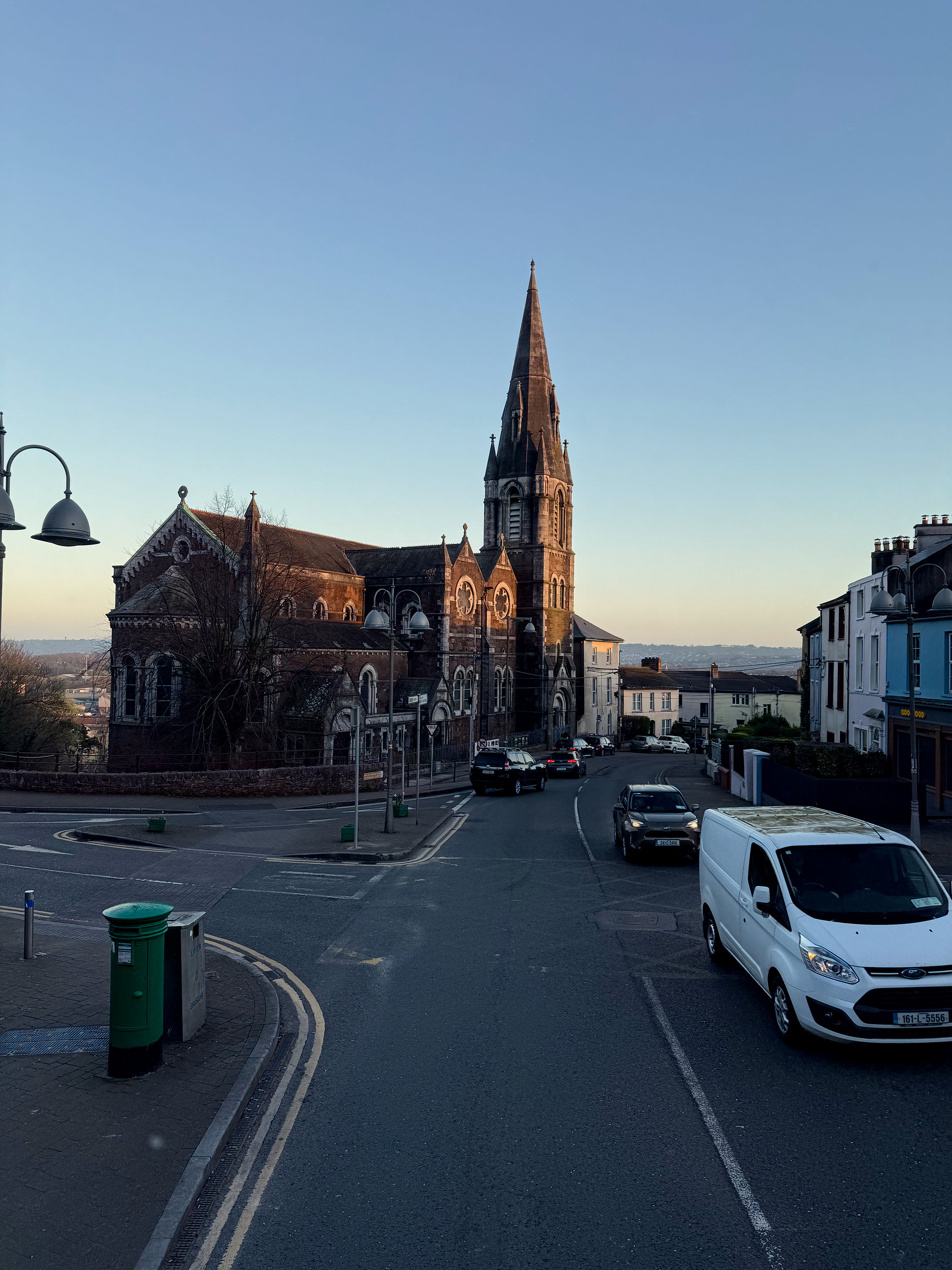
Renting a car in Ireland might feel intimidating at first—between the left-side driving, narrow roads, and abundance of roundabouts—but with a little prep (and a sense of humor), it quickly becomes part of your travel adventure. Driving gives you the freedom to explore off-the-beaten-path and connect with the destination on a deeper level.
To sum it all up and offer some parting words of advice: take your time, trust your instincts, and don’t be afraid to mess up a parking job or miss a turn—it’s all part of the experience. Before long, you’ll be waving to other drivers like a local, confidently navigating tight curves, and maybe even developing a strange fondness for roundabouts (well, maybe).
Safe travels, and I can’t wait to hear about your trip!
—
Questions for you
Do you usually rent a car when you travel, or do you prefer to skip it?
Have you ever rented a car at a destination where they drive on the opposite side of the road?
For locals – do you have any advice you would add to this list?
Where to next? You may also enjoy:
- Instagram Stories Highlight: Ireland
- Behind the Wheel in the South of France: A Road Trip Adventure
- 13 Things You Should Know Before Renting a Car in Puerto Rico
- Left-Hand Driving in St. Croix, USVI
- How to Find Cheap Flights
- 20 Questions You Should Ask a Potential Travel Partner Before You Leave Home
- What Happens When You Cancel a Non-refundable Trip?
- How to Split Travel Costs When One Person Earns More
- Why You Should Always Pack a Bandana When You Travel
- My Flight Got Canceled and All I Had to Wear Was This Dress
- I won a trip! (Now what?)
- All Airline Reviews
- All Travel Guides by Destination
- Checking In: Hotel Reviews
- Shop My Closet
- Exclusive Promo Codes + Discounts

